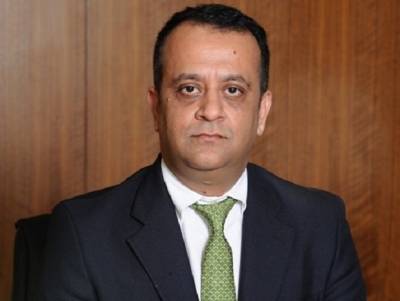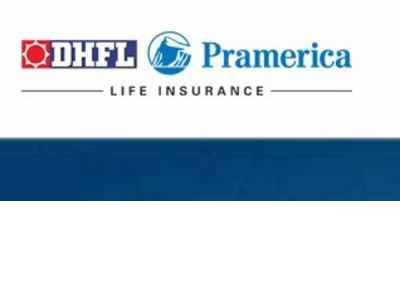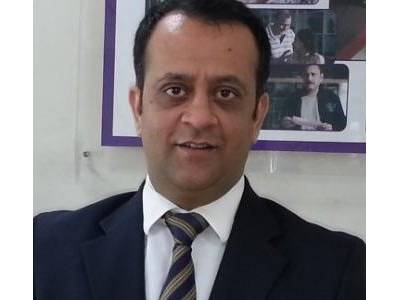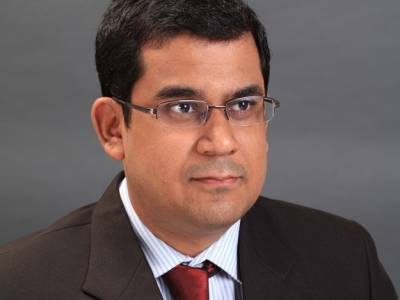Despite digital onslaught, offline still huge market:Jitin Paul, Bharti AXA
Brands use innovative ways to appeal to a consumer’s emotions, engage them and make a lasting impression. When it comes to advertising, the BFSI sector has definitely come a long way over the years. Once stuck to long format storytelling to bring their messages across insurance, banking and tax saving, the BFSI sector has delivered some of the most memorable campaigns by employing reliable marketing techniques like humour to bring out their message.
Bharti AXA Life Insurance, a joint venture between Bharti and AXA, has been steadily expanding its presence across the country with a large network of distributors. The company continues to provide innovative products and service offerings to cater to specific insurance and wealth management needs of customers.
Over the years, Bharti AXA Life Insurance has strongly built up its brand proposition of ‘Jeevan Suraksha Ka Naya Nazariya’ across markets and platforms. In conversation with Adgully, Jitin Paul, CMO, Bharti AXA Life Insurance, speaks at length about how this brand proposition was developed, the marketing and communication strategies, trends in the insurance space and much more. Excerpts:
What have been the key milestones for Bharti Axa?
Digital as a platform has shown tremendous increase in terms of sales. Since its inception online in 2011, we have used ‘Strategy of Proof’ for redefining life insurance as ‘Jeevan Suraksha Ka Naya Nazariya’.
We believe that promise needs to come through by something that you offer them and you just don’t leave them with a promise, saying we will do this for you or this is who we are without substantiating it. So, the consumer will want to know how we will translate ‘Jeevan Surakhsha Ka Naya Nazariya’ into benefit for him.
You have mentioned ‘Strategy of Proof’ – is that a global strategy?
Yes. ‘Strategy of Proof’ basically depends on what is sensibly called a ‘proof’, which means what is the reason why you are saying this. Like we say, ‘Jeevan Suraksha Ka Naya Nazariya’, which globally reminds about redefining life insurance. And that’s where we start building the real route why somebody should believe in your saying. We did extensive research to understand what the consumer believes in ‘Jeevan Suraksha Ka Naya Nazariya’. And we said – you know, it’s a customer lifecycle. We did a lot of research to know what the key point of expectation is, and found out that it was about getting their claims on time without any hassles. During our research, the respondents told us how people had to run from office to office to get their claims on time. And that’s when we created our first campaign. We created a proposition for our unit plan which said that we will give you your claim within 48 hours of receipt of claim. There are two components for the elite plan. One is the death claim, which basically requires investigation because we need to figure out whether the documents are in order and whether the declarations are at place. But the savings component of the insurance plan rightfully belongs to the customer. And during the time of the family business time type, for them the money becomes very important. So we said within 48 hours we will do it. We have the gravity to do it. And for every day of delay we will pay you 1 per cent of the fund and I am happy to tell you that out of the entire cases, 99.4 per cent claims were paid on time. There were only 3 or 4 cases where we weren’t able to pay on time, and we paid them 1 per cent of the fund.
When you come up with such kind of communication, do you back it up with a back-end sales team and the marketing team?
Absolutely. We realised that marketing entity just creates advertising. A large part of the proposition belongs to some other department. So, for example, in this case the department is servicing. Because they are the people who need to take the claims documents. Then our finance department gets involved because the cheque needs to be issued. The claims/ servicing department calculates exactly how much amount needs to be given to the consumer, the finance department handles the cheque. It builds the process first and then communicates. For us, we went a step ahead with the claims. We realised that usually the nominee is the mostly the homemaker. She is educated, but not exposed to the procedures because it is the husband who usually looks at the finance of a household. So, if tomorrow the wife is to submit a claim, she may not be familiar with the documents that need to be submitted or filling up the application form. For this, we created another proposition of a dedicated claim handler. And this is something that has come from the ‘Strategy of Proof’.
Thus, the proof has to be three things – you need to be the first in the industry, it needs to be relevant to the customer, and it needs to be communicable. We have a lot of proofs in the company which are first, relevant and communicable. We now offer claims in 10-15 languages, but we think maybe it can just pass off as an additional benefit and not something that you can use in advertising. Then sometimes something is relevant to the consumer but that proof is not the first in the industry. Therefore, strategy of proof, when it goes to the campaign phase, needs to pass through these three aspects. It needs to be relevant, otherwise it doesn’t make sense. It needs to be communicable, which means it needs to be big enough as a platform to make a mark in the market. We have been running this campaign for the last two years now and it has done exceedingly well for us. Our entire strategy for the last 2-3 years has been how do we come up with proofs and communicate them.
Since the last four years, we have also looked at digital as the emerging platform for growth from where we were selling the policies. We have realised that there is interaction and communication bearing out of digital. And we at that time were in a very transactional relationship on digital with our consumers. So they were coming on the platform, they were buying the policy, we were delivering them the policy bond and the consumers were happy. But we realised that we needed to take this relationship from being purely transactional to engagement, which compelled us to be on social media platforms. We started off first with Facebook and realised that majority of the landscape is talking about their products and services. After some research in the financial products category, we found that the consumers were not interested in them. Among the top 10 reasons why somebody engages with a company on a digital platform, product and service intent is at No. 8, which means people are not getting up on social media to pitch a product. They find it boring and irrelevant for the platform and we also find it completely non-sharable. Consumers will not share such content. So we said why don’t we take an approach, wherein we tell them who we are before we tell them what we do. ‘Jeevan Suraksha Ka Naya Nazariya’ is something that we have been using as our brand essence and brand theme for the last two years.
When we started off, we said ‘Naya Nazariya’ or ‘Fresh Perspective’ is something that we should celebrate. So we took that as the underlying theme for the brand and created from a fresh perspective. Thus, you will see the hashtags #NayaNazariya #FreshPerspective on any of our social media platforms.
However, fresh perspective is a very broad theme. How do we anchor it? We said that what we do becomes relevant if we anchor it in protection. Just to give you an example, in the first post that we had put out, which did really well, we said there are several kinds of colours in food, if you add all of these colours to your diet you will get a perspective. That’s a fresh perspective when looking at food. Nobody thought about saying ‘Yeh Naya Nazariya Hai’. We actually ran a contest asking people to click themselves with different coloured food and celebrated those colours week-on-week.
Which is the social media agency involved in the campaign? Could you tell us more about the creative thought?
Indigo Consulting is the social media agency, while GroupM has a separate team to handle our creative duties. A large part of the team sits in Delhi and plans there, but we have a team in Mumbai as well. We have created a series of content and special mention to the content that looked really well. So, three services that we did around the fresh perspective of protection involved celebrating three individuals who are doing something really ‘Naya Nazariya’. The first was a martial artist, who, along with developing physical skills was also training his mind. He said, ‘You are not able to manage a confrontational situation or protect yourself because your mind is not ready even though your body is. So it was basically an in-self protection, which was a very new perspective. We also celebrated an individual who spoke about protecting the environment, wherein he said, ‘I could have started an NGO of my own, but I decided to protect the environment by taking kids for treks. If they appreciate nature, then they will protect it. So, you are readying the next generation of people to protect the environment. In this way, people started associating us with a new, fresh perspective in protection. This helped us in garnering a lot of engagement. Our communication never states that here is this policy that has five features, why don’t you buy it. It doesn’t work. People want to know who you are, what kind of a person you are.
What have been some of the key milestones in the last two years at Bharti AXA?
A big milestone of us was the ‘Strategy of Proof’ campaign of Bharti AXA being a dedicated claims handler. Second was our ‘fresh perspective’ campaign on Facebook. On LinkedIn, we built up a corporate brand with multi-faceted strategy of growth. We are the most engaged brand on Facebook and we are also the No. 1 brand on LinkedIn in the insurance sector. As per Linkedin’s Total Brand Index (TBI), we are the No. 1 brand on the platform for 14 months running. These are basically the high points for us. And the reason why we have been able to achieve this largely is because we have got very consumer-focussed content. We have content that people are interested in and largely what happens is people start sharing content. Thus, you can minimise your media money by organic growth. And people engage with that content and find it share-worthy and that kind of tells what you do.
Over the last couple of years how have you seen the communication in the insurance sector changing?
I have seen that digital has a lot of focus, and that has changed because insurance is getting online. Insurance pre-dominantly used to be a push business, where people used to sell insurance. Slowly it is moving into a pull business, where the consumer is choosing to buy it. And that shift is also changing the dynamics of how you communicate. So, online is a completely consumer pull business. The consumer actually lands up on the platform, calculates the premium on his own, fills up the entire application form online, scans it and submits the documents online. Before buying an insurance plan, the consumer does his own evaluation by visiting the websites of different insurance companies, reading online reviews, visiting compare sites such as Policybazaar.com. Thus, the consumer is becoming more and more active in this category and that revolution is driven through digital.
People are looking for real reasons to buy; like the ‘Strategy of Proof’ basically states what is the reason that I should buy it. There used to be surrogates for the reasons to buy. The biggest reason why someone buys financial service is to secure one’s future and the trust factor. One part of this entire trust is to look for surrogates for trust. One is vintage. There are certain companies who have been in the market for 70 years. Then there are household needs who have tied up with global players. These business houses have been around for the longest time. They have tied up with global players in the insurance sector or there are people who have been in other sectors of financial services and now got into insurance. So people are now looking for surrogates to say why should I trust you because of these reasons. Also, people are now looking at real reasons to trust, which include whether your service is top-of-the-line or whether your products are comparable to the best in the market. Apart from having this basic level of trust factor, insurance players are going beyond being just product-based. Digital is making a big change in the way consumers are choosing products.
How has the consumer’s perception towards insurance changed and what role has communication played in this change?
I think communication has its limitations. Communication doesn’t change attitudes. It basically understands what the possible attitude is and targets that. So, depending on an advertising campaign to think about complete shift in consumer mind-set is putting too much pressure on advertising. But I think the insurance category is changing from the standpoint of what consumers are expecting from the category. For instance, tax-saving, which used to be one of the top triggers of the category, is coming down. People are choosing real reasons to buy insurance. I see protection still being the tipping point in the category, which means, what differentiates me from mutual fund is protection. And that’s something which consumers are repeatedly choosing and that’s a steady shift. I am seeing that protection also involves protection of the future, which means life-stage planning. This is from a Nielsen research. So it is prefixed by life and changes over the years. Secondly, there is an interpretational protection savings and for that the lead base is ‘child’. So the biggest trigger says I want to plan for my child’s future. Then there is the need to protect one’s family and there are changing positions every year. People invest in insurance for protection – it could be for an unforeseen, unfortunate event or life stage.
Has this change taken place in the last 2-3 years or did it begin much earlier?
I personally believe that the consumer is maturing and the exposure is maturing the consumer; the democratisation of information is changing the consumer. The consumer has a lot of avenues to understand what exists than the person who comes and speaks to him, and digital is changing that. He knows the difference between a mutual fund and insurance, FD and insurance. He knows what the difference between these categories is and what each of these categories has to offer. As much as it still is a protection-plus-savings pitch in India, people are increasingly saying that it’s not that they want their money to come back for everything, they want to choose a plan where they are investing just to cover themselves, and those kind of plans are doing really well online. In fact, term is almost 50 per cent of the entire online sales.
















Share
Facebook
YouTube
Tweet
Twitter
LinkedIn